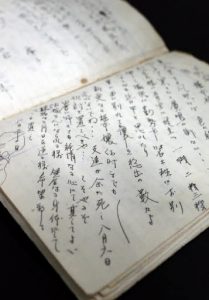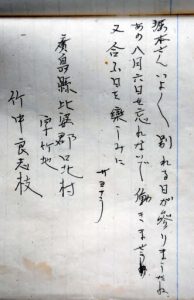Notebook contains messages written by young people soon after Hiroshima A-bombing
Nov. 1, 2018
by Kyosuke Mizukawa, Staff Writer
A notebook which contains the thoughts and feelings of 25 young people who had been working at the former Hiroshima Army Clothing Depot (located in Minami Ward, Hiroshima) and experienced the atomic bombing was recently found. These A-bombed warehouses still stand today. The notebook, in which the young workers recorded messages at the end of August, expresses their anger toward the United States and their determination to rebuild their lives. It also reflects their strong resolve to never forget August 6. The Peace Memorial Museum, located in Minami Ward, to which the notebook was recently donated, considers the notebook to be a very important artifact because it is an honest record that conveys the young people’s feelings soon after the A-bomb attack.
The notebook was kept by Hatsuyo Horimoto, 89, a resident of the city of Iwakuni, who had been working at the former Army Clothing Depot and experienced the atomic bombing at the age of 16. It was donated to the Peace Memorial Museum by her family at the end of August. Just prior to Ms. Horimoto returning to her home in Yamaguchi Prefecture after the end of the war, those who had worked alongside her and were staying at the same dormitory each wrote a message on one page, each page measuring 15 centimeters long and 21 centimeters wide. Some pages are dated and from these dates it appears that the messages were added to the notebook over a period of a few days from around August 20.
After the bombing, the Clothing Depot, which was located about 2.7 kilometers from the hypocenter, became a temporary relief station. Many of the injured who flocked to the relief station eventually died there one after another. The messages in the notebook include: “I will never be able to forget August 6. We must defeat hateful America and England.” (written by a woman from the present-day city of Yanai), and “We lost many of our friends on August 6. We should seek revenge for their deaths.” (written by a man from the present-day city of Kure). There are a striking number of messages that express anger and hatred toward the United States, bitterness that remained after the war ended.
Yoshie Hanazono, 89, a resident of the city of Miyoshi, was 16 years old at the time and worked at the former Clothing Depot. Writing under her maiden name, Takenaka, she said, “Let’s work together while never forgetting August 6.” She experienced the atomic bombing while at a factory in the Koi district of today’s Nishi Ward. The Clothing Depot had opened this facility so that, in the event of air raids, its functions would be spread out among more locations. A coworker, who was from the same community in the northern part of Hiroshima Prefecture, lost her life that day.
Ms. Hanazono, who led a life of farming with her husband after the war, brought up two children and now has great grandchildren. While reading what she had written 73 years ago, she said with a smile, “This reminds me of the many tragic things that happened at the time of the atomic bombing, like people who were badly injured and half-naked in tattered clothes. Because many people were killed by the bomb, I suppose I wrote ‘Let’s work together’ as a kind of duty for those who had survived.”
The notebook holds many similar messages with vows to work together and to never forget the day of the atomic bombing. A museum curator considers it notable that the writers began calling the day of the A-bomb attack “August 6” or “that day” within one month of the bombing and conveyed resolve not to forget their memories. The curator added that writings made soon after the bombing by those who were connected to the Clothing Depot are a rare discovery.
Takashi Horimoto, 63, is Ms. Horimoto’s eldest son. A resident of the city of Iwakuni, he had been entrusted with the notebook. About donating it to the museum, he said, “In addition to the existing warehouses of the Clothing Depot, I’d like this notebook to help convey the catastrophic destruction caused by the atomic bombing and the thoughts and feelings of the A-bomb survivors.” The Peace Memorial Museum plans to display this notebook in its New Collections Exhibition as soon as next year.
Keywords
Hiroshima Army Clothing Depot
The Hiroshima Army Clothing Depot was originally established as the Hiroshima branch of the Clothing Depot for the Imperial Japanese Army in 1905, and became the Hiroshima Army Clothing Depot in 1907. It was used to produce, repair, and store clothing, footwear, caps, and other gear for Japanese soldiers. Many young people from various parts of Hiroshima Prefecture worked there and there used to be a school for youth where teenage boys and girls working at the factory could study. Four reinforced red-brick warehouses (completed in 1913), which served as a temporary relief station immediately after the bombing, still exist today.
(Originally published on November 1, 2018)
A notebook which contains the thoughts and feelings of 25 young people who had been working at the former Hiroshima Army Clothing Depot (located in Minami Ward, Hiroshima) and experienced the atomic bombing was recently found. These A-bombed warehouses still stand today. The notebook, in which the young workers recorded messages at the end of August, expresses their anger toward the United States and their determination to rebuild their lives. It also reflects their strong resolve to never forget August 6. The Peace Memorial Museum, located in Minami Ward, to which the notebook was recently donated, considers the notebook to be a very important artifact because it is an honest record that conveys the young people’s feelings soon after the A-bomb attack.
The notebook was kept by Hatsuyo Horimoto, 89, a resident of the city of Iwakuni, who had been working at the former Army Clothing Depot and experienced the atomic bombing at the age of 16. It was donated to the Peace Memorial Museum by her family at the end of August. Just prior to Ms. Horimoto returning to her home in Yamaguchi Prefecture after the end of the war, those who had worked alongside her and were staying at the same dormitory each wrote a message on one page, each page measuring 15 centimeters long and 21 centimeters wide. Some pages are dated and from these dates it appears that the messages were added to the notebook over a period of a few days from around August 20.
After the bombing, the Clothing Depot, which was located about 2.7 kilometers from the hypocenter, became a temporary relief station. Many of the injured who flocked to the relief station eventually died there one after another. The messages in the notebook include: “I will never be able to forget August 6. We must defeat hateful America and England.” (written by a woman from the present-day city of Yanai), and “We lost many of our friends on August 6. We should seek revenge for their deaths.” (written by a man from the present-day city of Kure). There are a striking number of messages that express anger and hatred toward the United States, bitterness that remained after the war ended.
Yoshie Hanazono, 89, a resident of the city of Miyoshi, was 16 years old at the time and worked at the former Clothing Depot. Writing under her maiden name, Takenaka, she said, “Let’s work together while never forgetting August 6.” She experienced the atomic bombing while at a factory in the Koi district of today’s Nishi Ward. The Clothing Depot had opened this facility so that, in the event of air raids, its functions would be spread out among more locations. A coworker, who was from the same community in the northern part of Hiroshima Prefecture, lost her life that day.
Ms. Hanazono, who led a life of farming with her husband after the war, brought up two children and now has great grandchildren. While reading what she had written 73 years ago, she said with a smile, “This reminds me of the many tragic things that happened at the time of the atomic bombing, like people who were badly injured and half-naked in tattered clothes. Because many people were killed by the bomb, I suppose I wrote ‘Let’s work together’ as a kind of duty for those who had survived.”
The notebook holds many similar messages with vows to work together and to never forget the day of the atomic bombing. A museum curator considers it notable that the writers began calling the day of the A-bomb attack “August 6” or “that day” within one month of the bombing and conveyed resolve not to forget their memories. The curator added that writings made soon after the bombing by those who were connected to the Clothing Depot are a rare discovery.
Takashi Horimoto, 63, is Ms. Horimoto’s eldest son. A resident of the city of Iwakuni, he had been entrusted with the notebook. About donating it to the museum, he said, “In addition to the existing warehouses of the Clothing Depot, I’d like this notebook to help convey the catastrophic destruction caused by the atomic bombing and the thoughts and feelings of the A-bomb survivors.” The Peace Memorial Museum plans to display this notebook in its New Collections Exhibition as soon as next year.
Keywords
Hiroshima Army Clothing Depot
The Hiroshima Army Clothing Depot was originally established as the Hiroshima branch of the Clothing Depot for the Imperial Japanese Army in 1905, and became the Hiroshima Army Clothing Depot in 1907. It was used to produce, repair, and store clothing, footwear, caps, and other gear for Japanese soldiers. Many young people from various parts of Hiroshima Prefecture worked there and there used to be a school for youth where teenage boys and girls working at the factory could study. Four reinforced red-brick warehouses (completed in 1913), which served as a temporary relief station immediately after the bombing, still exist today.
(Originally published on November 1, 2018)









